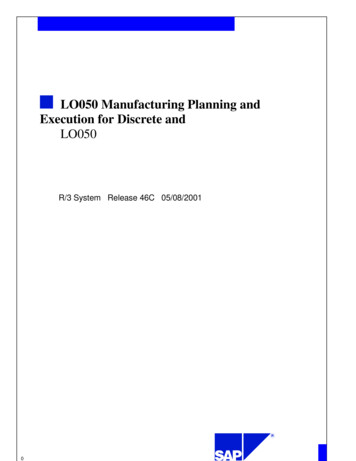
Transcription
How to make the Days for Girls LinersThis document provides an explanation of the liner, its purpose, and how to make it.Introduction:Days for Girls offers two distinct methods to make liners: If you have a serger, the Serger Strip method is an efficient way to make liners. (A serger is aspecial machine used to overcast raw edges.) To use this method you will need BOTH a sergerand a normal sewing machine.If you do not have a serger, you will want to use the “Turn and Topstitch” method which canbe done using just a normal sewing machine.What is a liner? What is the purpose of the liner in the Days for Girls washable menstruation kit?a. The liner is the washable ‘pad’ and it is held in place by the shield. The shield snaps around thebottom of the pantie. The shield has pockets at the ends. The liner is tri-folded and tucked intothe pockets which hold the liner in place.b.c.d.e.The shield is sized to allow for 1 or 2 or even 3 tri-folded liners to be inserted to provide thedesired level of absorbency.Days for Girls uses a tri-fold style of liner which allows for effective washing and quick drying.The tri-fold liner is made in a shape which is not offensive to hang out in the sunshine (sunshinekills bacteria) – the shape is that of a washcloth rather than a ‘pad’.Liners are made with 100% cotton flannel. Two pieces of flannel are needed for each liner.It is best to use colorful fabrics for the liners; use medium to dark shades to disguise stains. Ifyou have white, pale, and light-shades of flannel, it is best to dye them to a darker color beforemaking the liners. Be cautious when selecting/purchasing fabric. Follow the guidelines asdetailed in Section Four “Considerations for Selecting Appropriate Patterns and Colors ofFabric”.The Days for Girls kit is designed to last three full years with proper care. Use appropriatematerials and sew the liners carefully to ensure quality.Rev 11.20.2013Page 1
The remainder of this document is organized as follows:Section One: the Serger-style Liner.Here you will find concepts, considerations and step-by-step sewinginstructions for making liners in the Serger Strip method.Section Two: the Turn & Topstitch Liner (nickname T&T).Here you will find concepts, considerations and step-by-step sewinginstructions for making liners in the T&T method.Section Three: Making the Postpartum liner.The postpartum liner is larger; details found in this section.Section Four: Tips, Techniques, and Things to Know aboutmaking liners.These things are ‘good to know’!Rev 11.20.2013Page 2
Section One. Explanation and Sewing instructions for the Serger-style Liner.The serger-style of liner is pictured above. The liner is made with two pieces of flannel. One is narrower– called the Hot Spot – and one is larger, a square. Note the liner is pretty on both sides. It is importantto sew the pieces “dull sides together” to hide the whitish back side as much as possible. If using a mixof solids and prints, place the solid against the back side of the print. Having colors/prints on both sidesdisguises stains on both sides of the liner – important when hanging out to dry.Important considerations:1. The serger method of making liners is most efficient when done in strips. This strip process is explainedbelow. You could also make liners ‘one at a time’. You decide what is best for you to make a qualityliner.2. As noted, a serger overcasts the raw edges of the flannel. You may wonder why this cannot be doneusing the overcast or zigzag stitch on a regular sewing machine. The reason is, Days for Girls has beenusing the zigzag option for a long time and we have found that it just does not hold up; there is toomuch fraying. The same is true for edges cut with pinking shears. The Days for Girls Kit is designed tolast three full years and, to ensure this, zig zag and pinking on the liners is no longer allowed.3. What fabric is used to make liners? 100% cotton flannel. Flannel is the only fabric Days for Girls feels isappropriate for liners. Medium to dark colors are best; both prints and solids may be used. See SectionFour of this document for more guidelines regarding fabric selection.4. What is the best length of yardage for this serger strip process? A good length is 2½ yards (2.3 meters).With experience, you may find a different length works well for you; use what works for you. Usinglengths of 2½ yards maximizes efficiency and minimizes waste. In Section Four there is additional infoabout this.5. Let’s talk about the “cut size” of the fabric vs. the “finished size” of the liner. The serger is designed tocleanly cut an edge and overcast the edge at the same time. Thus, the “cut size” of the fabric must be abit larger than the expected finished size of the liner. The amount of fabric trimmed off during sergingvaries according to the habit of the operator. Suggested widths are provided in this document,however, you will have to decide what works best for you. Be certain to measure the finished liner andensure it is sized appropriately. Over time, the flannel liner will continue to shrink a bit as it is washedand dried; this is why it is so important that it is not made too small at the outset.Rev 11.20.2013Page 3
Preparing the strips - size and methods:Strips can be made by cutting or by tearing. Use these guidelines when deciding what will work bestfor you:a. If cutting: It is best to use a rotary cutter. It is important to measure accurately and cutprecisely. The width of the strips depends on how much is trimmed during the serging process.If very little is trimmed while serging, cut the wide strip 8 ½ inches wide and the narrow strip 5 ¾inches wide. After serging, the narrow strip should not be less than 5 ½ inches wide. Thefinished liner should not be smaller than 8 ¼ inches square. Cut the strips wider if necessary toensure the proper finished size.b. If tearing: Using the tearing method is much faster than cutting, however, tearing stretches andweakens the edge of the flannel. When serging, this stretched edge must be fully trimmed offto ensure a clean cut and stable stitches. Thus, the width of the strips are wider when using the‘tearing’ method. Measurements for tearing are given below.If you plan to use the tearing approach, here is a way to do it:1. Along the 44” end of the yardage, measure and clip the edge as follows: create threestrips measuring 9 ¼ inches wide (23.5 cm), and two strips measuring 6 ½ incheswide (16.5 cm). The fabric is usually wide enough to separately clip & tear off theselvages (discard them).2. Tear the flannel into strips beginning at each of the points where you made a cut3. Pair up a wide strip with a narrow strip; this ensures the two strips are equal lengthand allows for less fabric waste later in the process. (Given we made 3 wide stripsbut only 2 narrow strips, there will be an unused wide strip. Set it aside; when astack builds up, cut a series of narrow strips to pair up with all these unused wideones.)Rev 11.20.2013Page 4
Step-by-step instructions to make the liners using the Serger Strip method:1. Wash and dry the fabric; press lightly if badly wrinkled2. Tear or cut the strips per instructions above; use the method that works best for you.3. Serge both long sides of a narrow strip. After serging, the narrow strip should bebetween 5 ½ - 5 ¾ inches wide (14.0 – 14.6cm).4. Place the narrow strip down the center of a wide strip for the full length of the strips.Be sure to position them “dull sides together” (in sewing terms this is called “wrongsides together”).5. Using the regular sewing machine with a straight stitch, stitch the narrow strip to thewide strip. Stitch near the edge, directly over the serged stitches; this will further securethe edge of the narrow strip. Use a medium stitch length (avoid small stitches).6. Cut the strips into 9” pieces (22.8 cm).7. Serge-finish each liner using one of these methods: If rounding the corners - Serge around each square, rounding at the corners. Securethe start & stop point with a few stitches on the regular sewing machine.If rounding the corners - Serge the outer edge and slightly serge over the start pointand then gently move off edge of fabric. Pull, trim and dot with Fray Check.If square corners - pause serger at very edge of corner and turn fabric. At last cornerserge off the edge. Pull, trim and dot with Fray Check.If serging in ‘chain method’ ( a technique used by quilters), dot each corner with FrayCheck before or after cutting the chain into individual linersIf square corners - leave tails of thread before cutting the serger threads. Use a crochethook and weave the tails back through the serged seamThe liner is now finished. Measure it. The preferred finished size of the standard liner is 8 ½ x8 ½ inches (21.6 x 21.6 cm); it should not be smaller than 8 ¼ x 8 ¼ inches (21 x 21 cm). Ifnecessary, make adjustments to ensure proper finished size as you make more liners.Rev 11.20.2013Page 5
Picture of shield with liner tucked into pockets:Picture of a liner unfolded and two partly folded (hotspot is showing on top):These liners show the rounded corners.Picture of three liners all folded in tri-fold fashion:A serger:Rev 11.20.2013Page 6
Section Two. Explanation and Sewing instructions for the Turn & TopstitchLiner (T&T). Other nicknames for the T&T liner are: ‘stop sign liner’ and ‘octagon liner’.Shown below: Unfolded T&T liner on left. Tri-folded T&T liner on right, showing the top sideand the back side. The back side has the folds.The T&T liner is made with two pieces of flannel. The liner is reversible. For photo purposes weare using a solid color. It is very nice indeed to use bright colorful prints; use prints or solids ora combination of both (i.e., one side print and one side a solid). Using colors/prints in mediumto dark tones on both sides of the liner disguises stains – important when hanging out to dry.How much fabric is required to make a T&T style liner?The smallest piece of flannel to make a T&T liner is 8.25 x 9 inches (21x23 cm); a liner requires twopieces of this size. For efficiency, if you plan to make a lot of liners, we recommend beginning withlarger pieces of yardage. A 2.5 yard length works well (2.3 meters). With experience, you may find adifferent length works well for you; use what works for you. In Section Four of this document there ismore info on this. If you have smaller pieces of flannel that are not big enough for the strip method,that’s okay; just cut out the liner pieces individually using the pattern template. The instructions givenbelow include the steps to make the strips.What is the easiest way to cut long strips of flannel?When cutting the flannel strips for the T&T liners, it is easiest to use a rotary cutter. The rotary cuttercreates a clean-cut edge which is advantageous when sewing the narrow seams required in this process.An alternate method for making the flannel strips is by tearing. A concern with tearing is, it stretchesand weakens the edge of the flannel. Thus, it will be necessary to use wider strips to accommodate awider seam allowance to avoid sewing in the weakened area, which will then require trimming off theexcess in the seam allowance. Use whichever way works best for you, and ensure the finished size ofthe liner is correct. The finished liner should be 8.5 inches tall (21.6 cm); the width should be very closeto 8 inches (20.3 cm). When tri-folded, the liner generally measures 8.5 x 3 inches (21.6 x 7.6 cm).Rev 11.20.2013Page 7
What does the pattern look like and where can I get it?The pattern for the T&T liner can be downloaded from the website www.daysforgirls.org. Whenprinting the pattern, be sure to set the printer settings to print at full size (some software labels this“100%”, or it might be “actual size” or “no scaling” etc.) Often there is a check box for “fit to page”which is automatically selected – be sure to uncheck this box. It will print as two halves which you mustcut out and tape together. Cut precisely on the lines; follow the instructions to make the pattern. Afterprinting, take a ruler and measure the pattern to verify it is the size specified on the pattern. There isalso a ‘one inch’ square which you can measure to further verify size (one inch 2.54cm).Does this method use zig zag or pinking shears?No. You may be thinking of an obsolete design that Days for Girls has used in the past. However, afterseveral years we have found there is too much fraying on liners made with zigzag and/or pinking shears.The Days for Girls Kit is designed to last three full years; we had to improve the liner to make it last.This T&T style of liner was developed to provide a method for everyone to make liners, includingsomeone who does not own a serger.Step-by-step instructions to make liners using T&T method:1. Wash and dry the fabric; press lightly if badly wrinkled2. Cut long strips of flannel 8.25 inches wide (21cm)3. Lay out one strip of flannel with pretty side up. Place a second strip of flannel on top of itfor the length of the strip; second strip is to be positioned "pretty side down". In sewingterms, this is “right sides facing”.4. Cut strip into 9" pieces; each cut will yield a double layer of 8.25 x 9 inch pieces (21x23cm),enough for one liner. Each liner requires two pieces of flannel.5. Place the pattern template on top of the two pieces of flannel (ensure the flannel pieces are“right-sides-facing” as noted above). Cut away the triangle corners of the flannel pieces.Tip: to save time, you may want to stack additional layers of flannel and cut the cornersfrom four layers at one time. Just be sure the cuts are accurate on all layers.Rev 11.20.2013Page 8
6. Using a scant one-quarter inch seam, sew around the liner; leave a 2 inch opening forturning. Trim a bit at corners to remove bulk. (Or, alternate method for experiencedsewers: sew using a 1/8 inch seam allowance; just be sure the seam securely catches bothlayers.)7. Turn right-side out. Be sure to gently push out the corners.8. (optional) Press lightly. Pressing is recommended for three reasons: it will be easier to dothe next step (edge-stitching), you can ensure the corners are fully pushed out prior toedge-stitching, and the finished piece will look nicer.9. Sew an edge-stitch all around approximately 1/8 inch from the edge. Be sure to securelystitch the edge at the two-inch opening. Examine edge to verify a good seam all around.All done! To continue making more liners, return to step 4 and repeat.Finished liners, shown unfolded, partly folded, and tri-folded (showing back side):Rev 11.20.2013Page 9
Section Three. Making the Postpartum liner.Measurements for the postpartum liner:Days for Girls offers a kit for Postpartum use. See the website for more information,www.daysforgirls.org.At this time, the postpartum liner must be made using the serger method. The postpartumliner is larger, thus the strips must be cut wider. The preferred finished sizes for thepostpartum liner are as follows: the large piece is 12 x 10 ½ inches (30.5 x 26.5 cm), and the hotspot is 12 x 7 ½ inches (30.5 x 19 cm). Cut the strips appropriately to accommodate yourserging habits and to ensure the finished size is correct. (Slightly smaller is okay too, forexample, 11 ¾ x 10 ¼ overall.) Note: the postpartum shield is also larger; shield instructions areavailable on the website.At this time, the T&T style has not been adapted for the postpartum liner. Stay tuned!Rev 11.20.2013Page 10
Section Four. Tips, Techniques and Things to Know when making liners.Considerations for selecting appropriate patterns and colors of fabric:a.b.c.d.e.Fabric used for liners must be 100% cotton flannelMedium to dark colors are best to disguise stainsPretty, brightly colored prints are bestAvoid white and light colors (dye them if donated)Do not use prints with people, animals, snakes, reptiles, dragons, war-theme,camouflage, glam, and other culture-specific topics. The best prints are floral andgeometrics/graphics.f. Buy the best quality you can afford; a tightly woven flannel is better than a loose weave.g. Liners can be made with both sides matching, a mix of solids and prints, or contrastingpatterns. It’s up to you! Remember: medium to dark colors are best.Reasons for using 2 ½ yard lengths of flannel (2.3 meters):a. anything longer gets increasingly difficult to manage when sewingb. anything longer may get too wrinkled in the washing machine and dryerc. shorter lengths might result in more waste at the end of the strip when cutting down to9” pieces (that is, each strip will have a bit of waste, thus, more strips more waste)d. A 2 ½ yard length is a compromise between maximum efficiency in sewing andminimizing fabric wastee. Be aware that flannel shrinks when washing, and not all flannel shrinks at the same rate.f. Use whatever length of strip that works the best for you.Number of liners included in each kit:Current as of October 2013, Days for Girls includes 8 liners in each standard kit, and 10 liners ineach postpartum kit.THANK YOU for sewing liners for Days for Girls. Every liner you make helps to give a girlher days back. Health. Education. Dignity.Rev 11.20.2013Page 11
below. You could also make liners 'one at a time'. You decide what is best for you to make a quality liner. 2. As noted, a serger overcasts the raw edges of the flannel. You may wonder why this cannot be done using the overcast or zigzag stitch on a regular sewing machine. The reason is, Days for Girls has been











